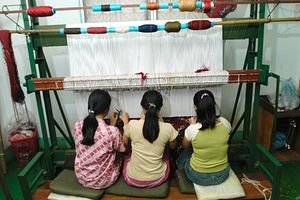After months of deliberation, Laos’ Prime Minister Thongloun Sisoulith announced this week that the country’s minimum wage will increase from 900,000 kip ($108) to 1.1 million kip per month. This rise is set to take effect from early next month.
The Lao Federation of Trade Unions (LFTU), a state-sponsored union organization, had petitioned for the minimum wage to be increased to 1.2 million kip per month, which they said was necessary because of the rising cost of living. But the Lao National Chamber of Commerce and Industry, a lobbying group, put up a strong fight, arguing that any minimum wage rise above 1 million kip would be disastrous for the country’s manufacturing industry, still nascent at best, while also asking for a two-year implementation period for the wage rise in order to soften the blow of extra salary expenditure.
Thongloun, it would seem, has sided with the forces of labor, not capital, in this dispute. Some analysts thought that the ruling Communist Party might have instead swayed in the other direction, given that national debt is mounting – 68 percent of GDP in 2016 – while the Party is keen to diversify its economy, long reliant on the export of natural resources. Unlike neighboring Myanmar, Cambodia, and Vietnam, Laos’ low-cost manufacturing sector remains in the developmental stages relatively speaking, which industry bodies argue won’t be helped by raising salaries.
While this is undoubtedly a victory for Laotian workers, some of the poorest in Southeast Asia, it could be a short-lived one. Over the last decade, Laos has tended to raise its minimum wage every three years. In early 2012, it was just 348,000 kip per month. That year, it almost doubled to 626,000 kip. Three years later, in 2015, it rose again. Now, three years on again, it has seen another increase.
But if the LFTU argued for a higher increase being necessary at the present time, it begs the question of whether the lower level will be a viable salary for Laotian workers over the next three years. Any visitor to Laos, especially to its larger cities, knows that some things are more expensive compared to some of its neighboring countries. The minister of industry and commerce admitted as much at a session of the National Assembly last year, when she said that the price of staple foods in Laos was up to 20 percent higher than in Thailand and Vietnam. Anecdotal evidence suggests food prices haven’t fallen since the minister’s comments; quite the opposite, in fact. Sources also say that even with the minimum wage increasing, daily living will only become slightly easier.
This wage rise announcement comes as the United Nations announced that Laos has fulfilled two of the three criteria to leave Least Developing Country (LDC) status. If things don’t go sour, then it could be upgraded to middle income country status by 2024. In his Lao New Year address, President Bounnhang Vorachit stressed that the Party will “strive to alleviate poverty and ensure the nation is moving towards graduation from LDC status by 2020 and becomes an upper-middle income country by 2030.”
Of the three criteria set by the UN, Laos has surpassed the targets for Gross National Income (GNI) per capita and for the Human Assets Index. GNI per capita is now $1,996, much higher than the $1,230 limit for LDC countries. But reporting on this UN assessment, Radio Free Asia pointed out, quoting an official at a poverty reduction fund, that while this news is good for the nation’s image, underlying issues of poverty remain unaddressed. “People are still poor and their living conditions have not improved much – in some areas of the country, during certain times of the year, people still earn less than U.S. $0.12 per month,” it quoted the unnamed official, who added that “more than 70 percent of Laotians in the country’s five northern provinces live below the poverty level.”
Statistical designations, like the UN’s use of GNI per capita, can paint a better picture than reality. Indeed, while absolute poverty rates (often defined as earning less than $1.25 per day) have dramatically fallen, income inequality has risen in Laos. From the 1990s to earlier this decade, the Gini coefficient of expenditure inequality rose from 0.311 to 0.364.
A good summation, using data from 2015, was published that year in the East Asia Forum. With both the inequality rise and the halving of absolute poverty, the report states that “the poor of Laos have become better off in real terms, but that the rich have benefited more in both proportionate and absolute terms.”
Indeed, such a remark could be applicable to the recent minimum wage rise. Of course, workers will benefit from an additional $25 per month in their pockets. But despite the opprobrium from certain sections of business community, some employers also think the wage rise will actually improve their own profits – most likely by more than the additional money they will now have to spend on workers.
Indeed, business owners have long complained about a lack of a labor force within Laos, with most workers, particularly skilled ones, leaving for neighboring countries to find employment. At least 170,000 Laotians are thought to be legally working in Thailand, where wages are much higher, with perhaps an equal number working there illegally by some estimates.
Now that the Lao minimum wage is set to increase, this could tempt some workers to return; and others not to leave in the first place. This, some reckon, will be a boon for the country’s low-cost manufacturing industry, which could now enjoy a reliable stock of employees. As Ounkham Ounyaseng, director general of the LFTU’s Labor Protection Department, recently told the Vientiane Times: “Employers should sympathize with workers and help them to improve their living standards as laborers are the ones enabling employers to make a profit.” For the Communist Party, then, the minimum wage rise decision could be seen as a victory for both labor and capital.

































